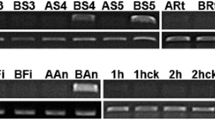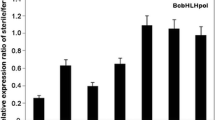Abstract
Pollen formation is important for plant sexual reproduction. To identify the genes that are involved in pollen formation, we performed the genome-wide transcriptional profiling in the flower buds of both male meiotic cytokinesis (mmc) mutant and its wild-type plants of Brassica campestris L. ssp. chinensis, syn. B. rapa L. ssp. chinensis. cDNA-amplified fragment length polymorphism (cDNA-AFLP) analysis showed that the mmc mutation resulted in changes in expression of a variety of genes. BcMF7, a transcript-derived fragment (TDF) accumulated in the wild-type flower buds was further characterized. The BcMF7 gene has 1161 bp in length with two introns. The full-length BcMF7 cDNA has 609 bp in length and encodes a protein of 129 amino acids. The deduced amino acid sequence of BcMF7 protein shares no similarity to any function-known protein in Swiss-Prot database, but has 8 protein kinase C phosphorylation sites, 2 caselin kinase II phosphorylation sites, 2 tyrosine kinase phosphorylation sites, 2 N-glycosylation sites and 2 N-myristolyation sites. Spatial and temporal expression patterns analysis showed that BcMF7 was expressed exclusively in pollen. The expression signal of BcMF7 was first detected at the tetrad stage of microspore development, reached a peak level at the uninucleate stage, and decreased to a slightly low level at the mature pollen stage. All these results show that BcMF7 may play a certain role in the signal transduction during pollen development.
Similar content being viewed by others
References
Twell D. Pollen developmental biology, in: O’Neill S D, Roberts J A, eds. Plant Reproduction, Annual Plant Reviews. Sheffield: Sheffield Academic Press, 2002. 86–153
Ye W Z, Cao J S, Xiang X, et al. Molecular cloning and characterization of the genic male sterility related gene CYP86MF in Chinese cabbage (Brassica campestris L. ssp. chinensis Makino var. communis Tsen et Lee). J Hort Sci & Biotech, 2003, 78: 319–323
Yu X L, Cao J S, Ye W Z, et al. Construction of an antisense CYP86MF gene plasmid vector and production of a male-sterile Chinese cabbage transformant by the pollen-tube method. J Hort Sci & Biotech, 2004, 79: 833–839
Wang Y Q, Yu Y X, Cao J S. Isolation and characterization of BcMF3, a gene expressed only in maintainer line in Chinese cabbage pak-choi (Brassica campestris L. ssp. chinensis Makino var. communis Tsen et Lee). Acta Genet Sin, 2004, 31: 1302–1308
Wang Y Q, Ye W Z, Cao J S, et al. Cloning and characterization of the microspore development related gene BcMF2 in Chinese cabbage pak-choi (Brassica campestris L. ssp. chinensis Makino). J Integr Plant Biol, 2005, 8: 4763–4872
Cao J S, Yu X L, Ye W Z, et al. Functional analysis of a male fertility CYP86MF gene in Chinese cabbage (Brassica campestris L. ssp. chinensis makino). Plant Cell Rep, 2006, 24: 715–723
Cao J S, Cao S C, Yi Q M. RAPD analysis on genomic DNA of Chinese cabbage and the other groups of Brassica. Acta Hort Sin, 1995, 22: 47–52
Bachem C W B, van der Hoeven R S, de Bruijn S M, et al. Visualization of differential gene expression using a novel method of RNA fingerprinting based on AFLP: Analysis of gene expression during potato tuber development. Plant J, 1996, 9: 745–753
Cho H T, Kende H. Expression of expansin genes is correlated with growth in deepwater rice. Plant Cell, 1997, 9: 1661–1671
Altschul S F, Madden T L, Schaffer A A, et al. Gapped BLAST and PSI-BLAST: A new generation of protein database search programs. Nucleic Acids Res, 1997, 25: 3389–3402
Gilbert C, Gaudry M, Naccache P H. Rapid priming of calcium mobilization and superoxide anion production in human neutrophils by substimulatory concentrations of phorbol esters: A novel role for protein kinase C and tyrosine phosphorylation in the up-modulation of signal transduction. Cell Signal, 1992, 4: 511–523
Grobe K, Powell L D. Role of protein kinase C in the phosphorylation of CD33 (Siglec-3) and its effect on lectin activity. Blood, 2002, 99: 3188–3196
Fernández B, Czech M P, Meisner H. Role of protein kinase C in signal attenuation following T cell receptor engagement. J Biol Chem, 1999, 274: 20244–20250
Clement S A, Tan C C, Guo J, et al. Roles of protein kinase C and alpha-tocopherol in regulation of signal transduction for GATA-4 phosphorylation in HL-1 cardiac muscle cells. Free Radic Biol Med, 2002, 32: 341–349
Tsuchida M, Manthei E R, Alam T, et al. Regulation of T cell receptor-and CD28-induced tyrosine phosphorylation of the focal adhesion tyrosine kinases Pyk2 and Fak by protein kinase C. J Biol Chem, 2000, 275: 1344–1350
Kawakami Y, Kitaura J, Hartman S E, et al. Regulation of protein kinase CβI by two protein-tyrosine kinases, Btk and Syk. Proc Natl Acad Sci USA, 2000, 97: 7423–7428
Park J, Hill M M, Hess D, et al. Identification of tyrosine phosphorylation sites on 3-phosphoinositide-dependent protein kinase-1 and their role in regulating kinase activity. J Biol Chem, 2001, 276: 7459–37471
Lin R, Hiscott J. A role for casein kinase II phosphorylation in the regulation of IRF-1 transcriptional activity. Mol Cell Biochem, 1999, 191: 169–180
Ahmed K, Davis A T, Wang H, et al. Significance of protein kinase CK2 nuclear signaling in neoplasia. J Cell Biochem Suppl, 2000, 35: 130–135
Ding D X-H, Vera J C, Heaney M L, et al. N-glycosylation of the human granulocyte-macrophage colony-stimulating factor receptor alpha subunit is essential for ligand binding and signal transduction. J Biol Chem, 1995, 270: 24580–24584
Butcau H, Pezet A, Ferrag F, et al. N-glycosylation of the prolactin receptor is not required for activation of gene transcription but is crucial for its cell surface targeting. Mol Endocrinol, 1998, 12: 544–555
Niu L, Heaney M L, Vera J C, et al. High-affinity binding to the GM-CSF receptor requires intact N-glycosylation sites in the extracellular domain of the beta subunit. Blood, 2000, 95: 3357–3362
Borgese N, Aggujaro D, Carrera P, et al. Role for N-myristoylation in protein targeting: NADII-cytochrome b5 reductase requires myristic acid for association with outer mitochondrial but not ER membranes. J Cell Biol, 1996, 135: 1501–1513
Boisson B, Giglione C, Meinnel T. Unexpected protein families including cell defense components feature in the N-myristoylome of a higher eukaryote. J Biol Chem, 2003, 278: 4341–43429
Asano T, Katagiri H, Takata K, et al. The role of N-glycosylation of GLUT1 for glucose transport activity. J Biol Chem, 1991, 266: 24632–24636
Li L-B, Chen N, Ramamoorthy S, et al. The role of N-glycosylation in function and surface trafficking of the human dopamine transporter. J Biol Chem, 2004, 279: 21012–21020
Author information
Authors and Affiliations
Corresponding author
Additional information
Supported by the National Natural Science Foundation of China (Grant No. 30370975) and the Key Sci-technology Project of Zhejiang Province, China (Grant No. 2005C12019-02)
Rights and permissions
About this article
Cite this article
Huang, L., Cao, J., Zhang, Y. et al. Characterization of a novel gene, BcMF7, that is expressed preferentially in pollen of Brassica campestris L. ssp. chinensis Makino. SCI CHINA SER C 50, 497–504 (2007). https://doi.org/10.1007/s11427-007-0056-7
Received:
Accepted:
Issue Date:
DOI: https://doi.org/10.1007/s11427-007-0056-7




